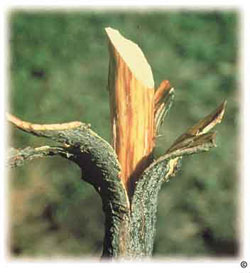What is Dutch Elm Disease?
Dutch elm disease is an aggressive fungal disease of elms native to America. The fungus is spread from tree to tree via the European elm bark beetle. As  the beetles tunnel in to lay eggs, the fungus enters the plants’ water-conducting system. Once inside the tree, the fungus begins to plug the vascular system. As a result, leaves wilt and the affected tree dies within a few months to a year.
the beetles tunnel in to lay eggs, the fungus enters the plants’ water-conducting system. Once inside the tree, the fungus begins to plug the vascular system. As a result, leaves wilt and the affected tree dies within a few months to a year.
What should I do if my tree if wilting?
If wilting symptoms are evident, cut twigs where wilting is occurring. Twigs should be one to two inches in diameter. Peel back the thin layer of bark to view the wood just underneath. If dark discoloration or streaks run the length of the twig, Dutch elm disease is suspect. Samples should be taken or sent to a diagnostic clinic for laboratory analysis.
What should I do if my tree has Dutch Elm Disease?
An elm diagnosed with Dutch elm disease must be removed and the wood disposed of. This practice helps slow the spread of the fungus to healthy trees.In locations where elms are growing next to each other, it is important to trench roots to prevent the spread of the disease from one tree to another through root grafts. It is possible to manage early infections by pruning out affected branches ten feet beyond visible streaking under the
bark.
Can I prevent Dutch Elm Disease?
Valuable trees without symptoms (or with minimal symptoms) can be injected with fungicides as a preventive action. The products usually last 2-3 years but have not been effective in every situation.



